Pioneer VSX-D309 User Manual
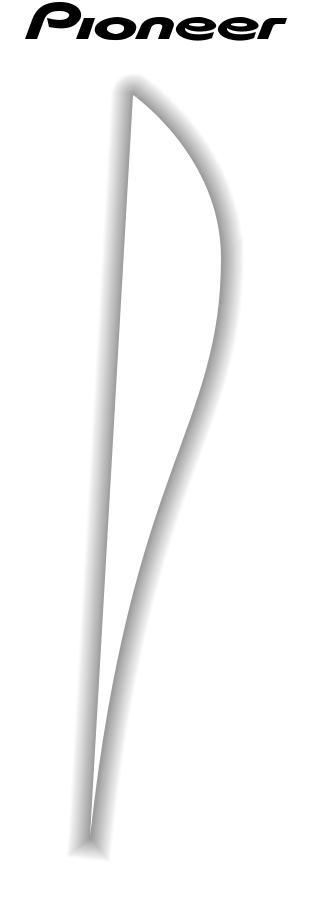
AUDIO/VIDEO
MULTI-CHANNEL RECEIVER
VSX-D309
Operating Instructions
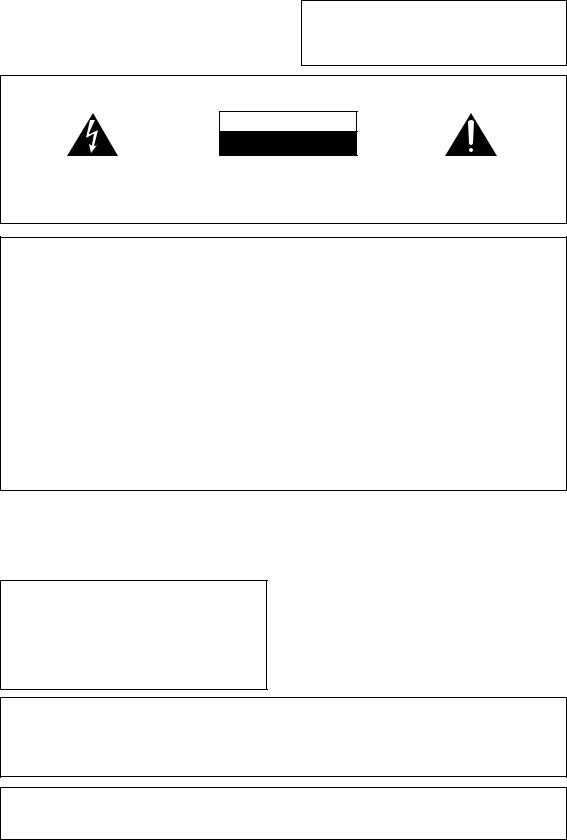
Congratulations on buying this fine Pioneer product.
Please read through these operating instructions so you will know how to operate your model properly. After you have finished reading the instructions, put them away in a safe place for future reference.
WARNING:TOPREVENTFIREORSHOCKHAZ-
ARD,DONOTEXPOSETHISAPPLIANCETORAINOR MOISTURE.
THE POWER SWITCH IS SECONDARY CONNECTED AND THEREFORE DOES NOT SEPARATE THE UNIT FROM MAINS POWER IN STANDBY POSITION.
IMPORTANT
The lightning flash with arrowhead symbol, within an equilateral triangle, is intended to alert the user to the presence of uninsulated "dangerous voltage" within the product's enclosure that may be of sufficient magnitude to constitute a risk of electric shock to persons.
CAUTION
RISK OF ELECTRIC SHOCK
DO NOT OPEN
CAUTION:
TO PREVENT THE RISK OF ELECTRIC SHOCK, DO NOT REMOVE COVER (OR BACK). NO USER-SERVICEABLE PARTS INSIDE. REFER SERVICING TO QUALIFIED SERVICE PERSONNEL.
The exclamation point within an equilateral triangle is intended to alert the user to the presence of important operating and maintenance (servicing) instructions in the literature accompanying the appliance.
This equipment has been tested and found to comply with the limits for a Class B digital device, pursuant to Part 15 of the FCC Rules. These limits are designed to provide reasonable protection against harmful interference in a residential installation. This equipment generates, uses, and can radiate radio frequency energy and, if not installed and used in accordance with the instructions, may cause harmful interference to radio communications. However, there is no guarantee that interference will not occur in a particular installation. If this equipment does cause harmful interference to radio or television reception, which can be determined by turning the equipment off and on, the user is encouraged to try to correct the interference by one or more of the following measures:
–Reorient or relocate the receiving antenna.
–Increase the separation between the equipment and receiver.
–Connect the equipment into an outlet on a circuit different from that to which the receiver is connected.
–Consult the dealer or an experienced radio/TV technician for help.
IMPORTANT NOTICE
The serial number for this equipment is located on the base. Please write this serial number on your enclosed warranty card and keep it in a secure area. This is for your security.
[For Canadian model]
This Class B digital apparatus complies with Canadian ICES-003.
[Pour le modèle Canadien]
Cet appareil numérique de la classe B est conforme à la norme NMB-003 du Canada.
[For Canadian model]
CAUTION: TO PREVENT ELECTRIC SHOCK DO NOT USE THIS (POLARIZED) PLUG WITH AN EXTENSION CORD, RECEPTACLE OR OTHER OUTLET UNLESS THE BLADES CAN BE FULLY INSERTED TO PREVENT BLADE EXPOSURE.
ATTENTION: POUR PREVENIR LES CHOCS ELECTRIQUES NE PAS UTILISER CETTE FICHE POLARISEE AVEC UN PROLONGATEUR, UNE PRISE DE COURANT OU UNE AUTRE SORTIE DE COURANT, SAUF SI LES LAMES PEUVENT ETRE INSERESS A FOND SANS EN LAISSER AUCUNE PARTIE A DECOUVERT.
CAUTION:
This product satisfies FCC regulations when shielded cables and connectors are used to connect the unit to other equipment. To prevent electromagnetic interference with electric appliances such as radios and televisions, use shielded cables and connectors for connections.
Information to User
Alteration or modifications carried out without appropriate authorization may invalidate the user's right to 2 operate the equipment.
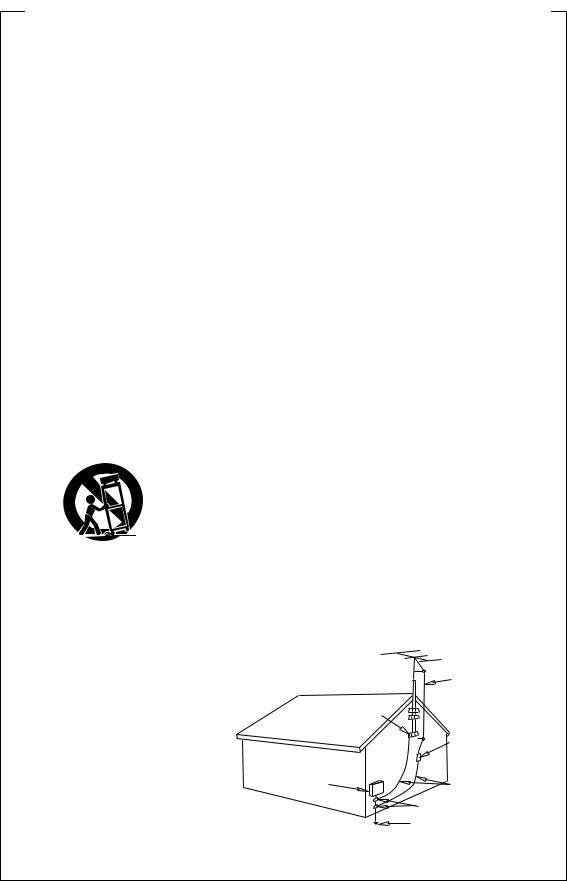
IMPORTANT SAFETY INSTRUCTIONS
READ INSTRUCTIONS — All the safety and operating instructions should be read before the product is operated.
RETAIN INSTRUCTIONS —The safety and operatinginstructionsshouldberetained for future reference.
HEED WARNINGS — All warnings on the product and in the operating instructions should be adhered to.
FOLLOW INSTRUCTIONS — All operating and use instructions should be followed.
CLEANING — Unplug this product from the wall outlet before cleaning. The product should be cleaned only with a polishing cloth or a soft dry cloth. Never clean with furniture wax, benzine, insecticides or other volatile liquids since they may corrode the cabinet.
ATTACHMENTS— Do notuse attachments not recommended by the product manufacturer as they may cause hazards.
WATER AND MOISTURE — Do not use this product near water — for example, near a bathtub, wash bowl, kitchen sink, or laundry tub; in a wet basement; or near a swimming pool; and the like.
ACCESSORIES — Do not place this product on an unstable cart, stand, tripod, bracket, or table. The product may fall, causing serious injury to a child or adult, and serious damage to the product. Use only with a cart, stand, tripod, bracket, or table recommended by the manufacturer, or sold with the product. Any mounting of the product should follow the manufacturer’s instructions, and should use a mounting accessory recommended by the manufacturer.
CART — A product and cart combination should be moved with care. Quick stops, excessive force, and uneven surfaces may cause the product and cart combination to overturn.
VENTILATION — Slots and openings in the cabinet are provided for ventilation and to ensure reliable operation of the product and to protect it from overheating, and these openings must not be blocked or covered. The openings should never be blocked by placing the product on a bed, sofa, rug, or other similar surface. This product should not be placed in a built-in installation such as a bookcase or rack unless proper ventilation is provided or the manufacturer’s instructions have been adhered to.
POWER SOURCES — This product should be operated only from the type of power source indicated on the marking label. If you are not sure of the type of power supply to your home, consult your product dealer or local power company.
LOCATION – The appliance should be installed in a stable location.
NONUSE PERIODS – The power cord of the appliance should be unplugged from the outlet when left un-used for a long period of time.
GROUNDING OR POLARIZATION |
OBJECT AND LIQUID ENTRY — Never |
||
÷ If this product is equipped with a |
push objects of any kind into this product |
||
polarized alternating current line plug (a |
through openings as they may touch |
||
plug having one blade wider than the |
dangerous voltage points or short-out |
||
other), it will fit into the outlet only one |
parts that could result in a fire or electric |
||
way. This is a safety feature. If you are |
shock. Never spill liquid of any kind on |
||
unable to insert the plug fully into the |
the product. |
|
|
outlet, try reversing the plug. If the plug |
SERVICING — Do not attempt to service |
||
should still fail to fit, contact your |
this product yourself as opening or |
||
electrician to replace your obsolete |
removing covers may expose you to |
||
outlet. Do not defeat the safety purpose |
dangerous voltage or other hazards. |
||
of the polarized plug. |
Refer all servicing to qualified service |
||
÷ If this product is equipped with a three- |
personnel. |
|
|
wire grounding type plug, a plug having |
DAMAGE REQUIRING SERVICE — Unplug |
||
a third (grounding) pin, it will only fit into |
this product from the wall outlet and |
||
a grounding type power outlet. This is a |
refer servicing to qualified service |
||
safety feature. If you are unable to insert |
personnel under |
the |
following |
the plug into the outlet, contact your |
conditions: |
|
|
electrician to replace your obsolete |
÷ When the power-supply cord or plug is |
||
outlet. Do not defeat the safety purpose |
damaged. |
|
|
of the grounding type plug. |
÷ If liquid has been spilled, or objects |
||
POWER-CORD PROTECTION — Power- |
have fallen into the product. |
||
supply cords should be routed so that |
÷ If the product has been exposed to rain |
||
they are not likely to be walked on or |
or water. |
|
|
pinched by items placed upon or against |
÷ If the product does not operate normally |
||
them,payingparticularattentiontocords |
by following the operating instructions. |
||
at plugs, convenience receptacles, and |
Adjust only those controls that are |
||
the point where they exit from the |
covered by the operating instructions |
||
product. |
as an improper adjustment of other |
||
OUTDOOR ANTENNA GROUNDING — If |
controls may result in damage and will |
||
an outside antenna or cable system is |
often require extensive work by a |
||
connected to the product, be sure the |
qualified technician to restore the |
||
antenna or cable system is grounded so |
product to its normal operation. |
||
as to provide some protection against |
÷ If the product has been dropped or |
||
voltage surges and built-up static |
damaged in any way. |
|
|
charges. Article 810 of the National |
÷ When the product exhibits a distinct |
||
ElectricalCode,ANSI/NFPA70,provides |
change in performance — this indicates |
||
information with regard to proper |
a need for service. |
|
|
grounding of the mast and supporting |
REPLACEMENT PARTS |
— When |
|
structure, grounding of the lead-in wire |
replacement parts are required, be sure |
||
to an antenna discharge unit, size of |
the service technician has used |
||
grounding conductors, location of |
replacement parts specified by the |
||
antenna-discharge unit, connection to |
manufacturer or have the same |
||
grounding electrodes, andrequirements |
characteristics as the original part. |
||
for the grounding electrode. See Figure |
Unauthorized substitutions may result |
||
A. |
in fire, electric shock, or other hazards. |
||
LIGHTNING — For added protection for this |
SAFETY CHECK — Upon completion of any |
||
productduringalightningstorm,orwhen |
service or repairs to this product, ask |
||
it is left unattended and unused for long |
the service technician to perform safety |
||
periods of time, unplug it from the wall |
checks to determine that the product is |
||
outlet and disconnect the antenna or |
in proper operating condition. |
||
cable system. This will prevent damage |
WALL OR CEILING MOUNTING — The |
||
to the product due to lightning and |
product should not be mounted to a |
||
power-line surges. |
wall or ceiling. |
|
|
POWER LINES — An outside antenna |
HEAT — The product should be situated |
||
system should not be located in the |
away from heat sources such as |
||
vicinity of overhead power lines or other |
radiators, heat registers, stoves, or other |
||
electric light or power circuits, or where |
products (including |
amplifiers) that |
|
itcanfallintosuchpowerlinesorcircuits. |
produce heat. |
|
|
When installing an outside antenna |
|
|
|
system, extreme care should be taken |
|
|
|
to keep from touching such power lines |
|
|
|
or circuits as contact with them might |
|
|
|
be fatal. |
|
|
|
OVERLOADING — Do not overload wall |
|
|
|
outlets, extension cords, or integral |
|
|
|
convenience receptacles as this can |
|
|
|
result in a risk of fire or electric shock. |
ANTENNA |
|
|
|
|
||
|
LEAD IN |
|
|
|
WIRE |
|
|
GROUND |
|
|
|
CLAMP |
|
|
|
|
ANTENNA |
|
|
|
DISCHARGE UNIT |
||
|
(NEC SECTION 810-20) |
||
ELECTRIC |
GROUNDING CONDUCTORS |
||
SERVICE |
(NEC SECTION 810-21) |
||
EQUIPMENT |
|
|
|
|
GROUND CLAMPS |
|
|
|
POWER SERVICE GROUNDING |
||
Fig. A |
ELECTRODE SYSTEM |
|
|
|
(NEC ART 250, PART H) |
||
NEC — NATIONAL ELECTRICAL CODE
3

Features
DTS* (Digital Theater Systems) decoder equipped 
DTS is a digital sound system introduced in theaters. Playback of DVD, LD, and CD recorded in DTS audio creates the environment of a theater or the sensation of a concert hall in your home.
Dolby** Digital and Dolby Pro Logic
No need to worry about program formats! When playing Dolby Digital or Dolby Pro Logic software in the 2(Dolby) mode, decoding switches automatically according to the input signal. All you have to do is sit back and enjoy! (When connecting a DVD/LD player or LD player using the 2RF (AC-3) output, a commercially available RF demodulator (RFD-1) is required.)
ADVANCED THEATER modes
Four sound modes that enhance DTS and Dolby audio performance by simulating the environment of a movie theater (DRAMA, ACTION), or the ambience of a concert hall (MUSICAL). With EXPANDED THEATER, you can enjoy Dolby Pro Logic encoded software in simulated Dolby Digital.
Various Surround Effects (DSP)
The DSP (Digital Signal Processing) surround mode allows you to transform your living room into six different sonic environments when listening to music or watching movies.
Midnight Listening Mode
When late night hours or other factors require that the volume be kept low, the surround effects may tend to become less than satisfactory. When the midnight listening mode is on, you can enjoy the effects of quality surround sound even at low volumes.
DVD 5.1 channel input
A special 5.1 Channel input makes the VSX–D309 fully compatible with Dolby Digital decoders and DVD players with 5.1 channel outputs.
The Energy-saving Design
This unit is designed to use minimal electricity when power is switched OFF (in Standby mode). Regarding the value of the power consumption in standby mode, refer to “Specifications” on pages 44.
Remote Control of Other Components
The supplied remote control can be used to operate a variety of other components simply by recalling the appropriate preset code. In addition, the multi-operation functions allow you to perform a variety of operations automatically.
*“DTS” and “DTS Digital Surround” are trademarks of Digital Theater Systems, Inc. Manufactured under licence from Digital Theater Systems, Inc.
** Manufactured under license from Dolby Laboratories. "Dolby", "Pro Logic" and double-D symbol are trademarks of Dolby Laboratories. Confidential unpublished works. © 1992-1997 Dolby Laboratories. All rights reserved.
4
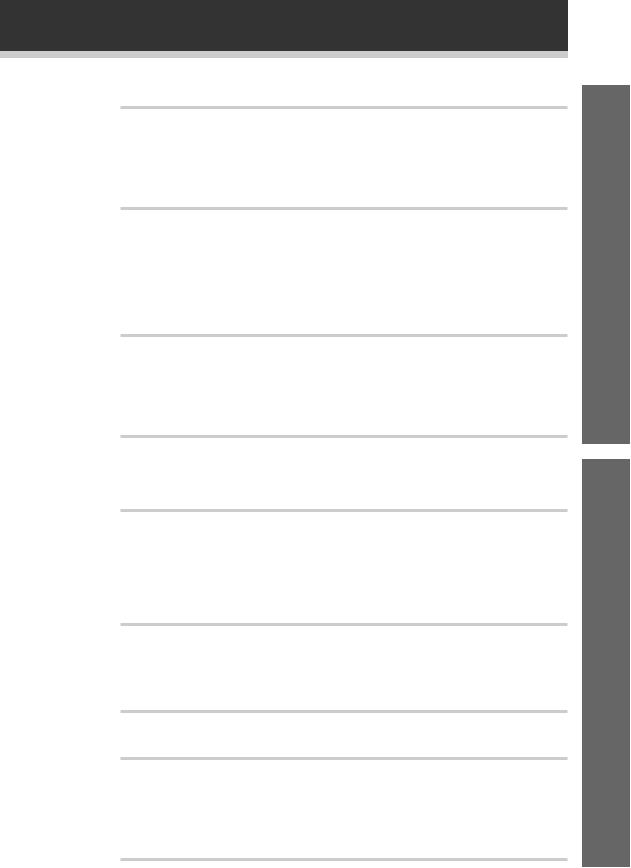
Table of Contents |
|
Features................................................................. |
4 |
Introductory Information ..................................... |
6 |
Checking the Supplied Accessories ............................................................... |
6 |
Using this Manual ........................................................................................... |
6 |
Installing the Receiver .................................................................................... |
6 |
When Making Cable Connections: ................................................................. |
6 |
Preparing the Remote Control ........................................................................ |
7 |
Connecting Your System ..................................... |
8 |
Connecting Antennas ..................................................................................... |
8 |
Connecting Audio Components ..................................................................... |
9 |
Connecting DVD 5.1 Channel Components ................................................. |
10 |
Connecting Video Components .................................................................... |
10 |
Connecting Digital Components ................................................................... |
11 |
Connecting Speakers ................................................................................... |
12 |
AC OUTLET [SWITCHED 100 W (0.8 A) MAX] ............................................ |
13 |
Preparations........................................................ |
14 |
Setting Up for Surround Sound .................................................................... |
14 |
Setting the volume level of each channel .................................................... |
19 |
Setting Up the Remote Control .................................................................... |
20 |
Clearing the Remote Control Settings .......................................................... |
22 |
Direct Function ............................................................................................. |
22 |
Displays & Controls............................................ |
23 |
Front Panel ................................................................................................... |
23 |
Display .......................................................................................................... |
24 |
Remote Control ............................................................................................ |
25 |
Sound Modes ..................................................... |
27 |
Learning about the Sound Modes ................................................................ |
27 |
Switching ANALOG/DIGITAL Signal Input .................................................... |
28 |
Playing a Source ........................................................................................... |
28 |
Playing Sources with Dolby Digital or DTS Sound ........................................ |
29 |
Selecting a Sound Mode .............................................................................. |
30 |
Using in MIDNIGHT Listening Mode ............................................................ |
31 |
Using the Tuner .................................................. |
32 |
Finding a Station ........................................................................................... |
32 |
Tuning Directly to a Station ........................................................................... |
33 |
Memorizing Stations .................................................................................... |
33 |
Recalling Memorized Stations ...................................................................... |
34 |
Making a Recording ........................................... |
35 |
Making an Audio or a Video Recording......................................................... |
35 |
Controlling the Rest of Your System ................ |
36 |
CD / MD / CD-R / VCR / LD Player Controls ................................................. |
36 |
Cassette Deck Controls ................................................................................ |
37 |
DVD / DVR Player Controls ........................................................................... |
38 |
DTV Controls ................................................................................................ |
39 |
Cable TV / Satellite TV / TV Controls ............................................................. |
40 |
Additional Information....................................... |
41 |
up Set
Operation
Troubleshooting ............................................................................................ |
41 |
|
Preset Code List ........................................................................................... |
43 |
|
Specifications ............................................................................................... |
44 |
5 |
|
|
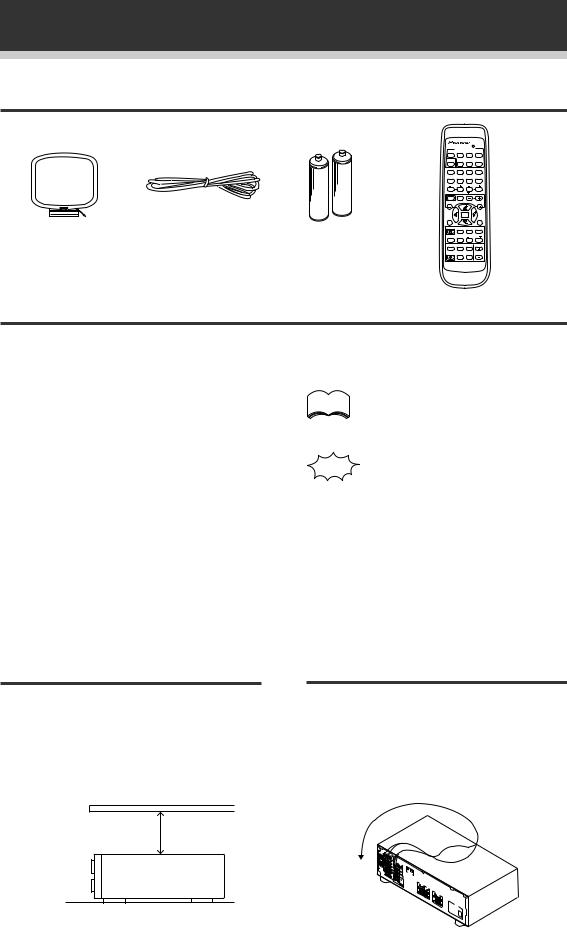
Introductory Information
Checking the Supplied Accessories
Please check that you've received the following supplied accessories:
AM loop antenna |
FM wire antenna |
AA size IEC R6P batteries (x2)
Î
MULTI CONTROL
DVD/LD TV/SAT VCR/DVR CD
CD-R/
RECEIVER TUNER TAPE/MD TVCONT
2DSPMODE MIDNIGHT 5.1CH
1 |
2 |
3 |
4 |
|
CHANNEL |
TEST |
ATT |
SIGNAL |
|
SELECT |
TONE |
SELECT |
|
|
5 |
6 |
7 |
8 |
|
CHANNEL |
EFFECT |
|
||
LEVEL |
|
|||
9 |
0 |
‡ |
ENTER |
|
|
|
10 |
DISC |
|
|
FUNC |
|
CH |
|
|
|
|
|
|
VOL |
TV CONTROL |
VOL |
|
|
|
|
|
||
|
FQ |
|
|
|
ST |
|
|
ST |
|
|
ENTER |
TOP |
|
|
MENU |
|
|
MENU |
|
|
FQ |
|
|
|
SOURCE CLASS |
MPX |
BAND |
|
|
|
7 |
|
8 |
3 |
D.ACCESS |
|
CHANNEL |
|
|
1 ¡ 4 ¢
LOUDNESS FUNCTION MUTING
FL |
REMOTE MASTER |
RECEIVER DIMMER |
SETUP VOLUME |
AUDIO/VIDEOPRE-PROGRAMMED
REMOTECONTROLUNIT
Using this Manual
Remote control unit
This manual is for the VSX-D309 audio/video multichannel receiver. It is divided into two main sections:
Set up
This section covers installing your receiver and connecting up all the other components in your home theater system to it. It also describes how to set up a multi-channel speaker system to take full advantage of the great surround sound features of your receiver.
Operation
This section shows you how to use every feature of the receiver and its remote control unit. It also covers using the supplied remote control to operate your other home theater components. To find out more about a specific button, control or indicator, see Displays & Controls starting on page 23. This will point you to the relevant chapter in the manual. In the Additional Information section (p.41-44) you'll find a troubleshooting section and specifications.
Installing the Receiver
Please note:
•Do not place objects directly on top of this unit. This would prevent proper heat dispersal.
•When installing in a rack, shelf, etc., be sure to leave more than 8 inches of space above the receiver.
The following symbols are used throughout this manual:
memo |
Provides detailed precautions and |
|
advice on operations, etc. |
Indicates that display is blinking.
When Making Cable
Connections:
Be careful not to arrange cables in a manner that bends the cables over the top of this unit as shown in the illustration. If the cables are brought over this unit, the magnetic field produced by the transformers in this unit may cause a humming noise to come from the speakers.
8 inches (20 cm.)
Receiver
R
L
2
R |
L |
R
 L
L
R
L
6
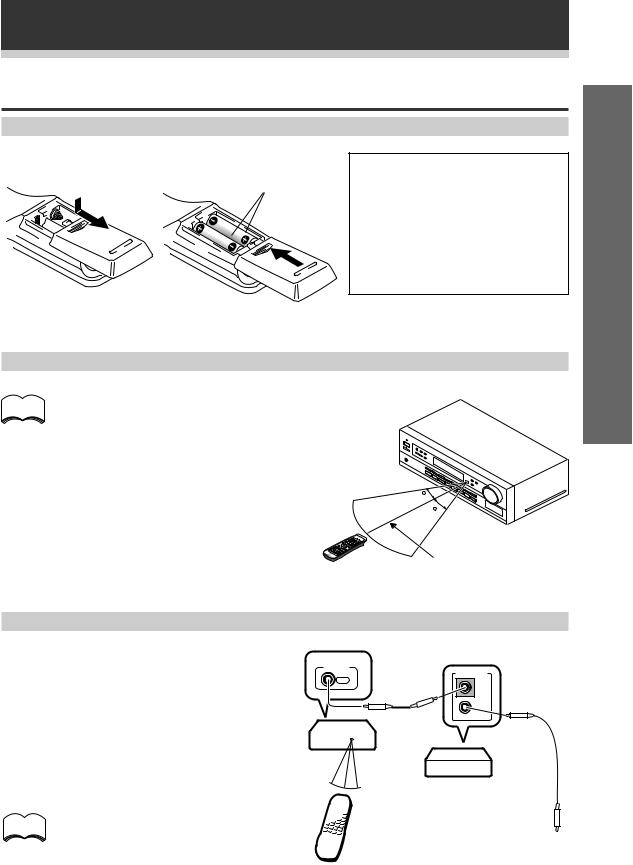
Introductory Information
Preparing the Remote Control
Loading the batteries
Dry cell batteries (AA size IEC R6P × 2)
CAUTION!
Incorrect use of batteries may result in such hazards as leakage and bursting. Observe the following precautions:
¶Never use new and old batteries together.
¶Insert the plus and minus sides of the batteries properly according to the marks in the battery case.
¶Batteries with the same shape may have different voltages. Do not use different batteries together.
Operating range of remote control unit
memo The remote control may not work properly if:
¶There are obstacles between the remote control and the receiver's remote sensor.
¶Direct sunlight or fluorescent light is shining onto the remote sensor.
¶The receiver is located near a device that is
emitting infrared rays. |
30 |
¶ The receiver is operated simultaneously with |
30 |
another infrared remote control unit. |
|
23ft (7m)
Operating other Pioneer components
By connecting a control cord (optional), you can |
|
|
control other Pioneer equipment using this remote |
|
CONTROL |
control unit. Point the remote control unit towards |
|
OUT |
the remote sensor of this unit, even when operating |
|
|
other equipment. |
|
|
The remote control signals are received by the |
|
|
|
|
|
remote sensor of this unit, and sent to the other |
|
|
devices via the CONTROL OUT terminal. |
VSX-D309 |
|
memo |
You can also control Pioneer components |
|
by pointing the receiver's remote control |
||
|
||
|
directly at the component. This type of |
|
|
operation does not require control cords. |
|
|
Remote control unit |
CONTROL
IN
OUT
Other Pioneer products with Î mark
Connect to CONTROL IN terminal of other Pioneer products with Î mark.
up Set
7
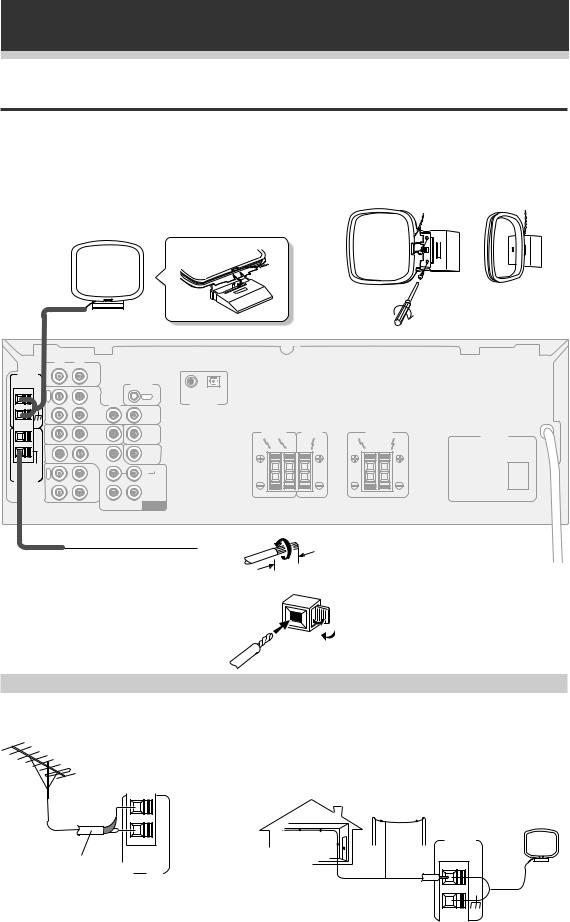
Connecting Your System
Connecting Antennas
Connect the AM loop antenna and the FM wire antenna as shown below. To improve reception and sound quality, connect external antennas (see Using external antennas, below). Always make sure that the receiver is switched off and unplugged from the wall outlet before making or changing any connections.
AM loop antenna
Assemble the antenna and connect to the receiver. Attach to a wall, etc. (if desired) and face in the direction that gives the best reception.
R |
L |
|
|
|
|
AM LOOP |
|
|
|
|
|
ANTENNA IN |
CD |
|
|
|
|
|
|
|
CONTROL |
|
|
O |
|
|
|
COAX |
OPT |
U |
|
|
OUT |
PCM/2/DTS |
|
T |
|
|
|
||
|
VCR/ |
VIDEO |
|
DIGITAL |
IN |
|
DVR |
|
|
|
|
IN |
|
IN |
OUT |
|
|
|
|
TV/ |
|
TO |
FRONT |
CENTER |
|
IN |
IN |
MONITOR |
SPEAKERS |
SPEAKER |
|
|
|
SAT |
|
TV |
|
|
|
|
|
|
R |
L |
|
|
|
DVD |
|
SUB |
||
|
IN |
IN |
|
|
||
|
/LD |
WOOFER |
|
|
||
|
|
FRONT |
PREOUT |
|
|
|
FM |
|
|
|
SURROUND |
|
|
UNBAL |
R |
OUT |
|
|
|
|
75Ω |
E |
R |
L |
|
|
|
C |
CD-R |
|
|
|||
FM |
|
|
|
|
|
|
ANTENNA |
|
/TAPE |
|
|
|
|
|
P |
/MD |
|
|
|
|
|
L |
IN |
|
CENTER |
|
|
|
A |
|
|
|
||
|
Y |
|
SUB |
|
|
|
|
|
|
DVD 5.1 CH |
|
|
|
|
|
|
WOOFER |
INPUT |
|
|
SURROUND |
|
|
SPEAKERS |
AC OUTLET |
|
R |
L |
|
FM wire antenna
Connect the FM wire antenna and fully extend |
3/8 in. (10mm) Antenna snap connectors |
vertically along a window frame or other suitable |
Twist the exposed wire strands together |
area, etc. |
and insert into the hole, then snap the |
|
connector shut. |
Using external antennas
7 To improve FM reception 7 To improve AM reception
Connect an external FM antenna.
Connect a 15-18 feet length of vinyl-coated wire to the AM antenna terminal without disconnecting the supplied AM loop antenna.
For the best possible reception, suspend horizontally outdoors.
Outdoor antenna
75 Ω coaxial cable
AM LOOP
ANTENNA
FM |
Indoor antenna |
UNBAL |
|
75Ω |
(Vinyl-coated wire) |
FM |
|
ANTENNA |
|
15-18 ft (5–6m)
8
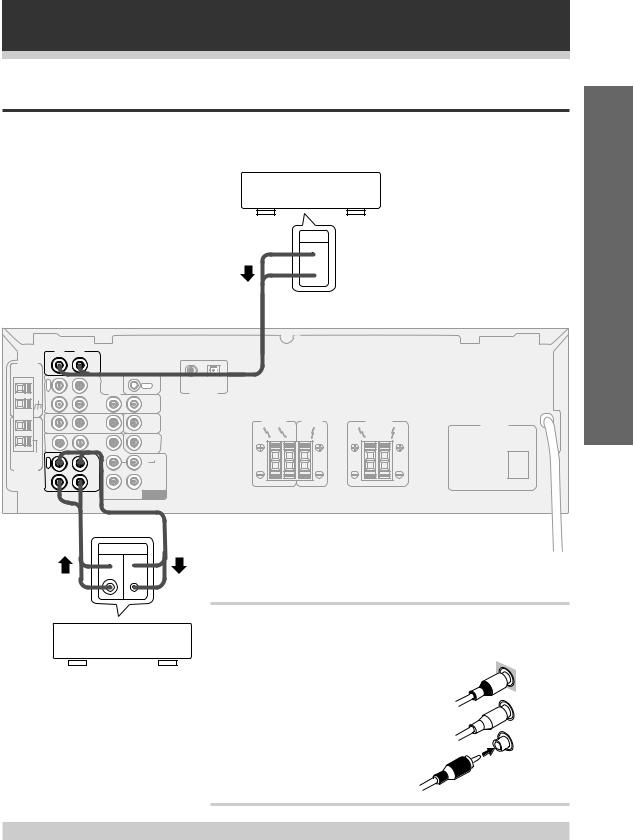
Connecting Your System
Connecting Audio Components
Connect your audio components as shown below. These are analog connections. When connecting equipment, always make sure the power switched off and the power cord is disconnected from the wall outlet.
CD player
OUT
 L
L
 R
R
R L
AM LOOP |
|
|
|
|
|
ANTENNA IN |
CD |
|
|
|
|
|
|
|
CONTROL |
|
|
O |
|
|
|
COAX |
OPT |
U |
|
|
OUT |
PCM/2/DTS |
|
T |
|
|
|
||
|
VCR/ |
VIDEO |
|
DIGITAL |
IN |
|
DVR |
|
|
|
|
IN |
|
IN |
OUT |
|
|
|
|
TV/ |
|
TO |
FRONT |
CENTER |
|
IN |
IN |
MONITOR |
SPEAKERS |
SPEAKER |
|
|
|
SAT |
|
TV |
|
|
|
|
DVD |
|
SUB |
R |
L |
|
IN |
/LD |
IN |
WOOFER |
|
|
|
|
FRONT |
PREOUT |
|
|
|
FM |
|
|
|
SURROUND |
|
|
UNBAL |
R |
OUT |
|
|
|
|
75Ω |
E |
R |
L |
|
|
|
C |
CD-R |
|
|
|||
FM |
|
|
|
|
|
|
ANTENNA |
|
/TAPE |
|
|
|
|
|
P |
/MD |
|
|
|
|
|
L |
IN |
|
CENTER |
|
|
|
A |
|
|
|
||
|
Y |
|
|
|
|
|
SURROUND |
|
|
SPEAKERS |
AC OUTLET |
|
R |
L |
|
SUB |
DVD 5.1 CH |
WOOFER |
INPUT |
PLAY REC
 L
L 
R 
Cassette deck , CD-R MD, DAT etc.
Audio/Video cords
Use good quality audio/video cords with RCA/phono plugs at each end
to connect the audio or video components and a video |
connect |
the monitor/TV. |
|
Connect red plugs to R (right), white plugs to |
|
L (left), and the yellow plugs to VIDEO. |
|
Be sure to push home the plugs into their sockets.
up Set
Cassette deck placement
Depending on where the cassette deck is placed, noise caused by leakage flux from the transformer in the receiver may occur during playback. If you experience noise, move the cassette deck farther away from the receiver.
9
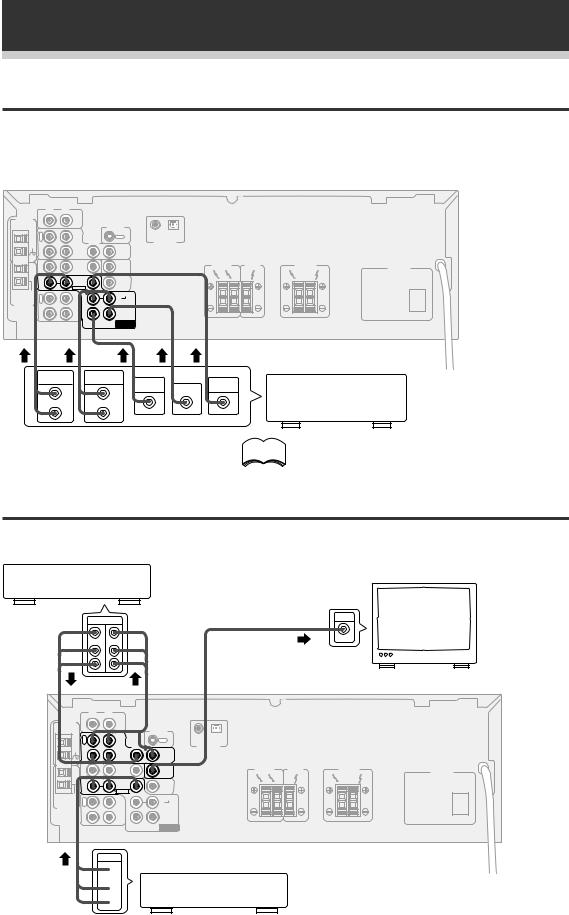
Connecting Your System
Connecting DVD 5.1 Channel Components
DVD and LD discs are compatible with both 2 channel and 5.1 channel audio output formats. Connections can be made from a DVD player, multi-channel decoder equipped with 5.1 analog outputs to the 5.1 analog inputs on this unit. Always make sure that the receiver is switched off and unplugged from the wall outlet before making or changing any connections.
R |
L |
|
|
|
|
AM LOOP |
|
|
|
|
|
ANTENNA IN |
CD |
|
|
|
|
|
|
|
CONTROL |
|
|
O |
|
|
|
COAX |
OPT |
U |
|
|
OUT |
PCM/2/DTS |
|
T |
|
|
|
||
|
VCR/ |
VIDEO |
|
DIGITAL |
IN |
|
DVR |
|
|
|
|
IN |
|
IN |
OUT |
|
|
|
|
|
TV/ |
|
TO |
FRONT |
CENTER |
|
|
IN |
IN |
MONITOR |
SPEAKERS |
SPEAKER |
|
|
|
|
SAT |
|
TV |
|
|
|
|
|
DVD |
|
SUB |
R |
L |
|
|
IN |
IN |
|
|
||
|
|
/LD |
WOOFER |
|
|
||
|
|
|
FRONT |
PREOUT |
|
|
|
|
FM |
|
|
|
SURROUND |
|
|
|
UNBAL |
R |
OUT |
R |
L |
|
|
|
75Ω |
E |
|
|
|||
FM |
C |
CD-R |
|
|
|||
ANTENNA |
|
/TAPE |
|
|
|
|
|
|
|
P |
/MD |
|
|
|
|
|
|
L |
IN |
|
CENTER |
|
|
|
|
A |
|
|
|
||
|
|
Y |
|
SUB |
|
|
|
|
|
|
|
DVD 5.1 CH |
|
|
|
|
|
|
|
WOOFER |
INPUT |
|
|
SURROUND |
|
|
SPEAKERS |
AC OUTLET |
|
R |
L |
|
FRONT |
SURROUND |
|
|
OUT PUT |
OUT PUT |
SUB |
VODEO |
L |
L |
WOOFER CENTER |
OUT |
|
|
||
R |
R |
|
|
Components equipped with 5.1 channel analog output jacks
memo The 5.1 channel input can only be used when DVD 5.1 CH is selected.
Connecting Video Components
Connect your video components as shown below. When connecting equipment, make sure the power is switched off and the power cord disconnected from the wall outlet.
VCR, DVR, etc.
OUT |
IN |
IN |
|
V |
VIDEO |
L |
|
R |
|
R L
TV monitor
AM LOOP |
|
|
|
|
|
ANTENNA IN |
CD |
|
|
|
|
|
|
|
CONTROL |
|
|
O |
|
|
|
COAX |
OPT |
U |
|
|
OUT |
PCM/2/DTS |
|
T |
|
|
|
||
|
VCR/ |
VIDEO |
|
DIGITAL |
IN |
|
DVR |
|
|
|
|
IN |
|
IN |
OUT |
|
|
|
|
|
TV/ |
|
TO |
FRONT |
CENTER |
|
|
IN |
IN |
MONITOR |
SPEAKERS |
SPEAKER |
|
|
|
|
SAT |
|
TV |
|
|
|
|
|
DVD |
|
SUB |
R |
L |
|
|
IN |
/LD |
IN |
WOOFER |
|
|
|
|
|
FRONT |
PREOUT |
|
|
|
|
FM |
|
|
|
SURROUND |
|
|
|
UNBAL |
R |
OUT |
|
|
|
|
|
75Ω |
E |
R |
L |
|
|
|
FM |
C |
CD-R |
|
|
|||
ANTENNA |
|
/TAPE |
|
|
|
|
|
|
|
P |
/MD |
|
|
|
|
|
|
L |
IN |
|
CENTER |
|
|
|
|
A |
|
|
|
||
|
|
Y |
|
|
|
|
|
SURROUND |
|
|
SPEAKERS |
AC OUTLET |
|
R |
L |
|
SUB |
DVD 5.1 CH |
WOOFER |
INPUT |
OUT
 V
V
 L
L
 R
R
DVD/LD player
10
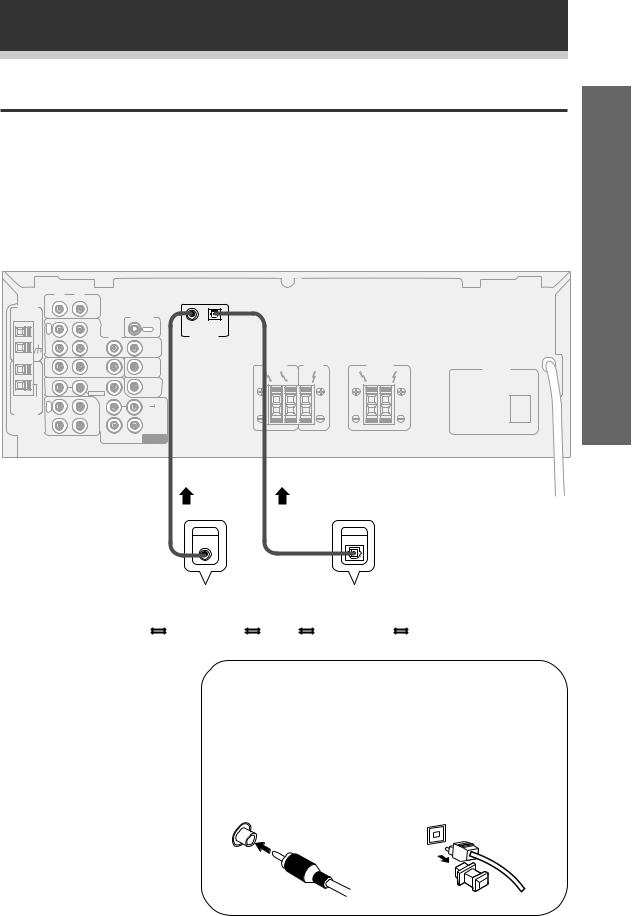
Connecting Your System
Connecting Digital Components
You can connect your audio and video equipment that have digital outputs by either digital or analog hook ups (you don't need to do both). In order to use DVDs with Dolby Digital/DTS soundtracks you need to make either digital audio connections or 5.1 channel analog connections (sse facing page) from your DVD player. You can make digital conections by using either coaxial or optical cords (you don’t need to use both). The quality of these two types of connections is the same but since some digital components only have one type of digital terminal, it is a matter of matching like with like (for example, the coaxial out from the component to coaxial in on the receiver). The VSX-D309 has one coaxial and one optical input for a total of two digital inputs. You can use either for any type of digital component (DVD, CD, CD-R, etc.). The diagram below just gives examples of possible connections.
Always make sure that the receiver is switched off and unplugged from the wall outlet before making or changing any connections.
R |
L |
|
|
|
|
AM LOOP |
|
|
|
|
|
ANTENNA IN |
CD |
|
|
|
|
|
|
|
CONTROL |
|
|
O |
|
|
|
COAX |
OPT |
U |
|
|
OUT |
PCM/2/DTS |
|
T |
|
|
|
||
|
VCR/ |
VIDEO |
|
DIGITAL |
IN |
|
DVR |
|
|
|
|
IN |
|
IN |
OUT |
|
|
|
|
TV/ |
|
TO |
FRONT |
CENTER |
|
IN |
IN |
MONITOR |
SPEAKERS |
SPEAKER |
|
|
|
SAT |
|
TV |
|
|
|
|
DVD |
|
SUB |
R |
L |
|
IN |
/LD |
IN |
WOOFER |
|
|
|
|
FRONT |
PREOUT |
|
|
|
FM |
|
|
|
SURROUND |
|
|
UNBAL |
R |
OUT |
|
|
|
|
75Ω |
E |
R |
L |
|
|
|
C |
CD-R |
|
|
|||
FM |
|
|
|
|
|
|
ANTENNA |
|
/TAPE |
|
|
|
|
|
P |
/MD |
|
|
|
|
|
L |
IN |
|
CENTER |
|
|
|
A |
|
|
|
||
|
Y |
|
SUB |
|
|
|
|
|
|
DVD 5.1 CH |
|
|
|
|
|
|
WOOFER |
INPUT |
|
|
SURROUND |
|
|
SPEAKERS |
AC OUTLET |
|
R |
L |
|
up Set
DIGITAL |
DIGITAL |
OUT |
OUT |
DVD player |
|
CD player |
|
|
|
7Digital audio cords/Optical cables
Commercially available digital audio coaxial cords (standard video cords can also be used) or optical cables (not supplied) are used to connect digital components to this receiver.
When you use optical digital input or output terminals, pull off the caps and insert the plugs. Be sure to insert completely.
Digital audio cord |
Optical cable |
(or standard video cord) |
|
11
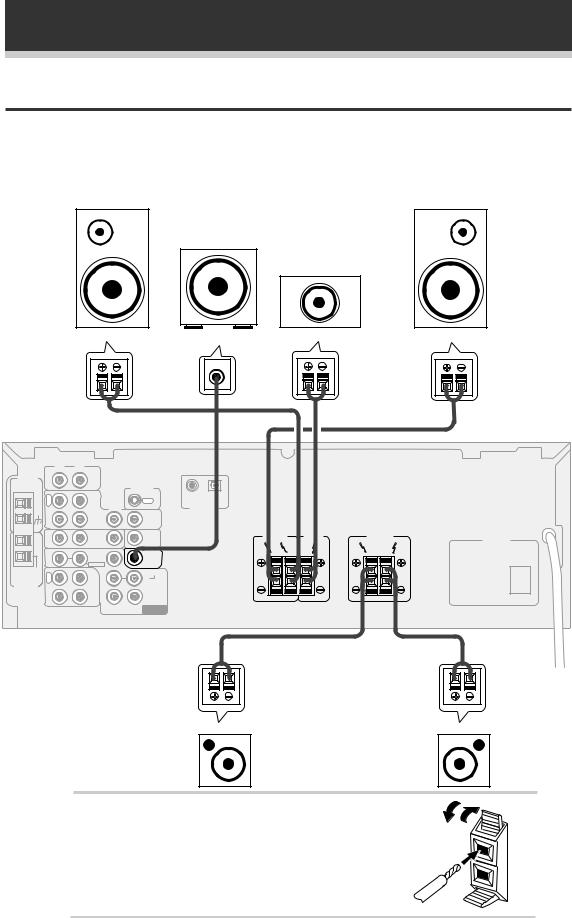
Connecting Your System
Connecting Speakers
Connect your speakers as shown below. Be sure to connect each speaker to the appropriate speaker terminal, and also to connect the positive and negative terminals correctly (so that the same wire is connected to the positive terminal of the receiver and the positive terminal of the speaker, and likewise with the negative). When connecting equipment, always make sure the power switched off and the power cord is disconnected from the wall outlet.
• Use speakers with a nominal impedance of 8 Ω to 16 Ω.
Front |
Powered |
Front |
(left) |
sub-woofer |
(right) |
|
|
Center |
INPUT
R |
L |
|
|
|
|
AM LOOP |
|
|
|
|
|
ANTENNA IN |
CD |
|
|
|
|
|
|
|
CONTROL |
|
|
O |
|
|
|
COAX |
OPT |
U |
|
|
OUT |
PCM/2/DTS |
|
T |
|
|
|
||
|
VCR/ |
VIDEO |
|
DIGITAL |
IN |
|
DVR |
|
|
|
|
IN |
|
IN |
OUT |
|
|
|
|
TV/ |
|
TO |
FRONT |
CENTER |
|
IN |
IN |
MONITOR |
SPEAKERS |
SPEAKER |
|
|
|
SAT |
|
TV |
|
|
|
|
DVD |
|
SUB |
R |
L |
|
IN |
IN |
|
|
||
|
/LD |
WOOFER |
|
|
||
|
|
FRONT |
PREOUT |
|
|
|
FM |
|
|
|
SURROUND |
|
|
UNBAL |
R |
OUT |
|
|
|
|
R |
L |
|
|
|||
75Ω |
E |
|
|
|||
C |
CD-R |
|
|
|||
FM |
|
|
|
|
|
|
ANTENNA |
|
/TAPE |
|
|
|
|
|
P |
/MD |
|
|
|
|
|
L |
IN |
|
CENTER |
|
|
|
A |
|
|
|
||
|
Y |
|
|
|
|
|
SURROUND |
|
|
SPEAKERS |
AC OUTLET |
|
|
|
|
R |
L |
|
SUB |
DVD 5.1 CH |
WOOFER |
INPUT |
Surround
(right)
Speaker terminals
Use good quality speaker wire to connect the speakers to the receiver.
1 Twist around 1/2 inch of bare wire strands together. 2 Unclip the speaker terminal and insert the wire.
3 Snap shut the speaker terminal to secure.
Surround
(left)
ª ·
12
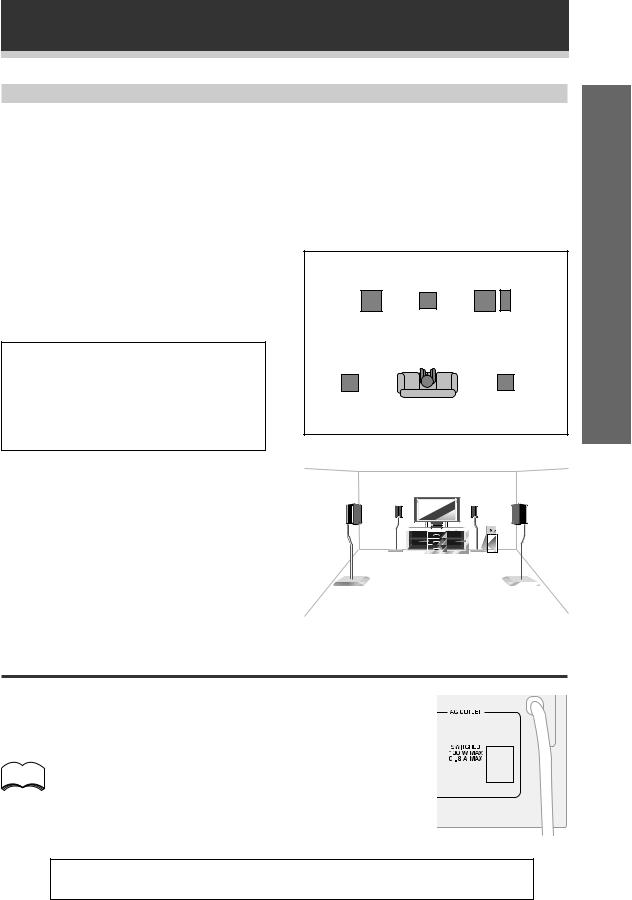
Connecting Your System
Hints on speaker placement
Speakers are usually designed with a particular placement in mind. Some are designed to be floorstanding, while others should be placed on stands to sound their best. Some should be placed near a wall; others should be placed away from walls. Follow the guidelines on placement that the speaker manufacturer provided with your particular speakers to get the most out of them.
•Place the front left and right speakers at equal distances from the TV.
•When placing speakers near the TV, we recommend using magnetically shielded speakers to prevent possible interference, such as discoloration of the picture when the TV is switched on. If you do not have magnetically shielded speakers and notice discoloration of the TV picture, move the speakers farther away from the TV.
•Install the center speaker above or below the TV so that the sound of the center channel is localized at the TV screen.
CAUTION!
If you choose to install the center speaker on top of the TV, be sure to secure it with putty, or by other suitable means, to reduce the risk of damage or injury resulting from the speaker falling from the TV in the event of external shocks such as earthquakes.
•If possible, install the surround speakers slightly above ear level.
•Try not to install the surround speakers farther away from the listening position than the front and center speakers. Doing so can weaken the surround sound effect.
To achieve the best possible surround sound, install your speakers as shown below. Be sure all speakers are installed securely to prevent accidents and improve sound quality.
Overhead view of speaker set up
Front |
|
Front |
Left |
Center |
Right |
|
|
Sub
Woofer
Surround |
Surround |
Left |
Right |
Listening
Position
3-D view of speaker set up
up Set
AC OUTLET [SWITCHED 100 W (0.8 A) MAX]
Power supplied through this outlet is turned on and off by the receiver's POWER switch.
Total electrical power consumption of connected equipment should not exceed 100 W (0.8 A).
Do not connect a heater, TV, etc.
|
|
|
memo |
• This unit should be disconnnected by removing the power plug from |
|
|
||
the wall socket when not in regular use, e.g., on vacation. |
|
|
|
|
|
|
• Do not connect appliances with high power consumption such as |
|
|
heaters, irons, or television sets to this AC OUTLET in order to avoid |
|
|
overheating and fire risk. This can also cause the receiver to malfunction. |
|
CAUTION:
DO NOT CONNECT A MONITOR OR TV SET TO THIS UNIT'S AC OUTLET.
13
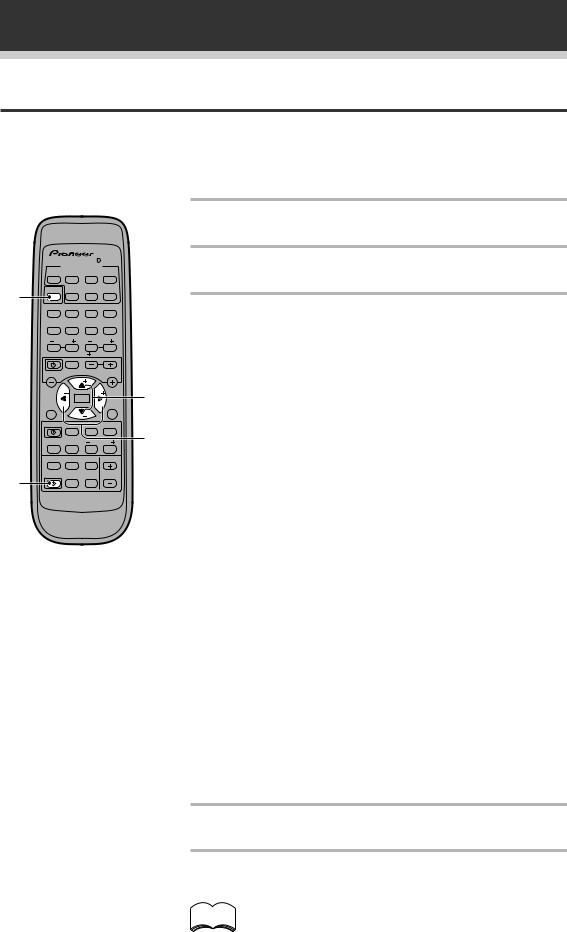
Preparations
Setting Up for Surround Sound
Be sure to switch the power of this unit on (The STANDBY indicator goes out).
To ensure the best possible surround sound, be sure to complete the following set up operations. This is particularly important when using the 2(Dolby/DTS) sound mode. You only need to make these settings once (unless you change the placement of your current speaker system or add new speakers, etc.). Refer to the following pages for detailed descriptions of the settings available for each mode.
Î
MULTI CONTROL
DVD/LD TV/SAT VCR/DVR CD
1 Press RECEIVER to turn the power on.
The STANDBY indicator goes out.
2 Press RECEIVER.
This switches the remote to the surround setup mode.
2 |
|
|
CD-R/ |
|
RECEIVER TUNER TAPE/MD TVCONT |
||||
2 DSPMODE MIDNIGHT 5.1CH |
||||
|
1 |
2 |
3 |
4 |
|
CHANNEL |
TEST |
ATT |
SIGNAL |
|
SELECT |
TONE |
SELECT |
|
5 |
6 |
7 |
8 |
3Press @ or #to select the mode you want to set.
|
LEVEL |
EFFECT |
|
For best results, start with “SPEAKER setting mode” and make your |
|
CHANNEL |
|
|
|
|
|
9 0 |
‡ |
ENTER |
|
initial adjustments in the order described below. |
|
|
|
10 |
DISC |
|
|
|
FUNC |
|
CH |
|
The current settings are displayed automatically. |
|
|
|
|
||
VOL |
TV CONTROL |
VOL |
|
|
|
|
|
|
SPEAKERS (Front, Center, Surround) setting mode (page 15) |
||
|
FQ |
|
|
4 |
|
|
ENTER |
|
ST |
Use to specify the type of speakers you have connected. |
|
|
ST |
|
|
||
MENU |
|
|
TOP |
|
|
|
|
MENU |
SUB WOOFER ON/PLUS/OFF setting mode (page 16) |
||
|
FQ |
|
|
|
|
1
14
SOURCE CLASS MPX BAND |
|
|
7 |
8 |
3 |
D.ACCESS |
CHANNEL |
¢ 3 |
1 ¡ |
4 |
|
LOUDNESS FUNCTION MUTING
FL |
REMOTE MASTER |
RECEIVER DIMMER |
SETUP VOLUME |
AUDIO/VIDEOPRE-PROGRAMMED
REMOTECONTROLUNIT
Use to specify the sub woofer as on or off.
Crossover frequency setting mode (page 16)
Use to determine which frequencies will be sent to the sub woofer (or “Large” speakers if you don’t have a sub woofer).
LFE attenuator setting mode (page 16)
Use to specify the peak level for the LFE channel and the crossover network for rerouted bass frequencies.
Low cut filter ON/OFF setting mode (page 17)
Use to cut the distorted sound from the sub woofer.
FRONT speakers distance setting mode (page 17)
Use to specify the distance from your listening position to your front speaker.
CENTER speakers distance setting mode (page 17)
Use to specify the distance from your listening position to your center speaker.
SURROUND speakers distance setting mode (page 17)
Use to specify the distance from your listening position to your surround speakers.
Dynamic range control setting mode (page 18)
Use to compress the dynamic range of the sound track.
Dual mono setting (page 18)
Use with 2 software that has dual mono encoding if you want to isolate one channel or listen in this specialized mono mode..
Coaxial digital input setting (page 18)
Use to specify the input to be assigned to the coaxial digital input.
Optical digital input setting (page 19)
Use to specify the input to be assigned to the optical digital input.
4 Press %or fito select the setting you want to set.
The setting is entered automatically.
5Repeat steps 3 and 4 to set other surround modes.
Press ENTER to exit the setting mode.
memo The setting mode is automatically exited if no operation is performed for 20 seconds.
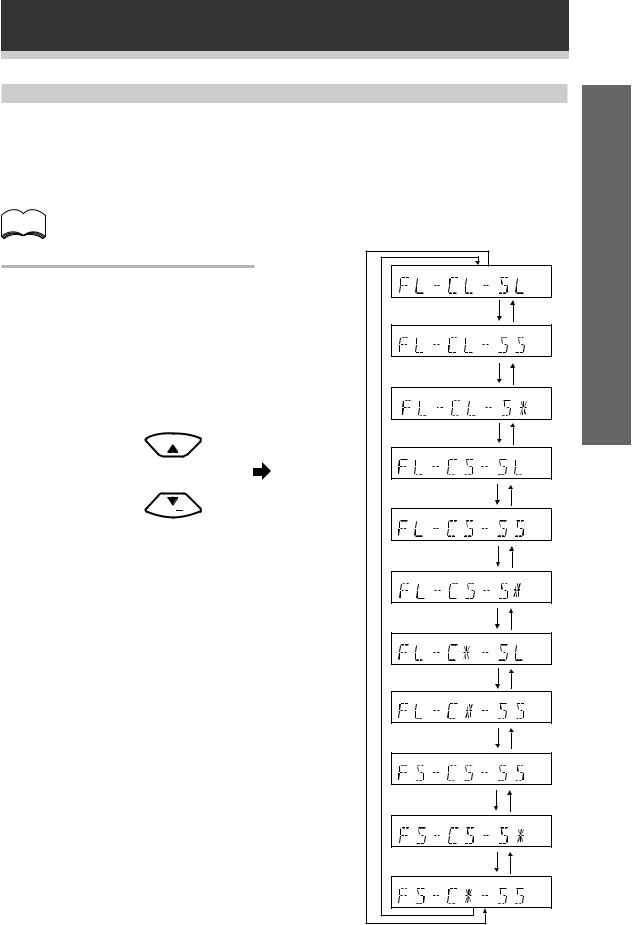
Preparations
SPEAKER (Front, Center, Surround) setting mode
This setting establishes the size and configuration of the speaker system you have connected. So, for example, here you set whether you have connected surround speakers or not, and how big they are. Selecting “Large” or “Small” will determine how much bass is sent by the receiver to the speakers being set. This setup system has certain constraints. For example, all your speakers cannot be set to “Large,” you need to decide which speakers should receive the most bass and set them to “Large.”
In the display, “F”, “C”, and “S” refer to front, center, and surround speakers respectively. Speaker size is denoted as “L” for large speakers, “S” for small speakers, and “*” (asterisk) if no speaker is connected.
memo If the cone size (radius) of the speaker is larger than 5 inches, please set to Large.
Switch the speaker setting mode according to the speakers you hooked up. Use the % or fi buttons.
The configurations shown on the right will appear in the display on the front of the receiver. One of them should match your speaker set up. Cycle through the different possibilities until you find the one that matches your set up.
FQ 
FQ
* Press # to advance to the next receiver setting, and press @to return to a previous receiver setting.
up Set
15
